The gardening season may be coming to a close for much of the country, but late fall is the perfect time to plan next year’s garden. You can still see the remains of plants kissed by frost, yet the fallen leaves also make it easier to see where shrubs and screens are needed.
Since you have months of planning ahead without having to rush to get plants in the ground, you can carefully choose the best plants, materials and design for your space. Here are some things you can plan on doing to customize your garden in the months ahead.
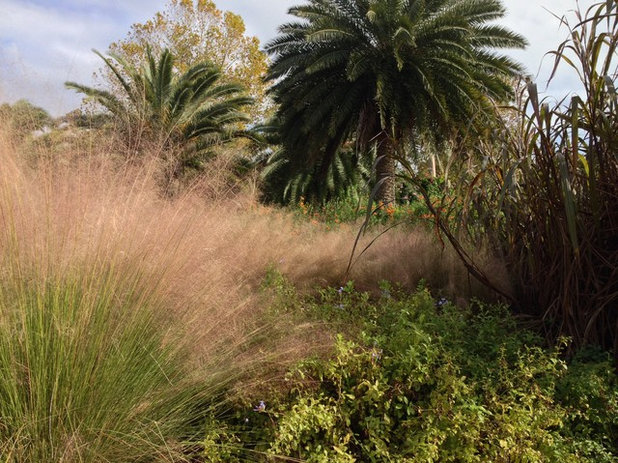 1. Think of the big picture.
1. Think of the big picture. Whether the view from your garden is of farmed fields, woodlands, tall buildings or the tops of suburban houses peeking over fences, you should consider your environment as a crucial part of your unique garden. Now that fall is here, dormant trees and shrubs make it easier to see what the bare branches will leave exposed in winter. Maximize your location by obscuring eyesores, opening up pretty views and making sure that your garden meshes well with the surrounding neighborhood.
Consider the different viewpoints that you, your neighbors and passersby have of your house. Can passing motorists see that pile of trash in your side yard that you’ve been meaning to throw away, or can the neighbors see you brushing your teeth in the morning because the rhododendron between your properties has lost its leaves?
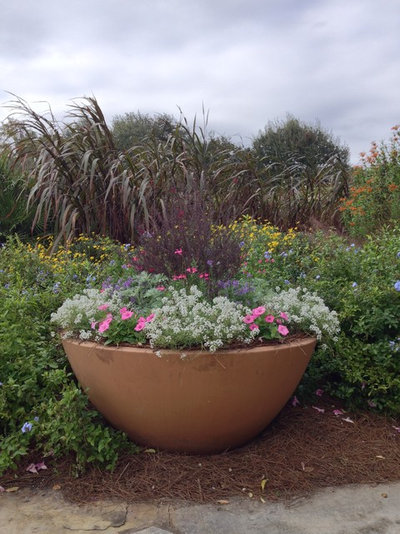 2. Create a focal point.
2. Create a focal point. Another way to distract from ugly features visible from your garden is with a dynamic focal point. This could be a large planted container, like the one shown here from the Jacksonville Zoo, or it might be a water feature that also masks unpleasant noises. A focal point could even be a particularly attractive shrub or a tree with a weeping habit that stands out from the other plants.
In formal gardens situate focal points such as urns in a symmetrical fashion at the center of a knot garden or at the end of a straight path. There it will attract attention to itself and the view beyond. In informal gardens it is important to have as few distractions as possible, so that heirloom pottery stands out. Place a focal point in front of massed plantings, against a hedge or at the curve of a path, where it will become the center of attention.
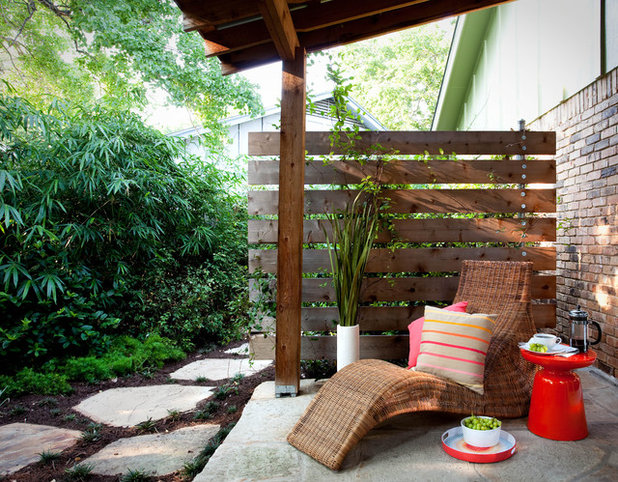
B. Jane Gardens
3. Create more privacy. Just because you want your garden to be the center of your visitors’ attention doesn’t mean that you want to be the center of attention yourself. The most common way to create privacy in the garden is to construct a fence around the perimeter, but if you’d rather not fence the entire property, it’s possible to build a screen like the one in this design by B. Jane Gardens. By placing a screen directly against the patio, the designer has created a sense of intimacy and an element of surprise.
A man-made barrier isn’t necessary, though. As long as safety isn’t an issue, it’s possible to plant dense hedges or vine-planted lattices where you would otherwise construct a fence. While you wait for the newly planted shrubs to fill in, plant tall perennials and annuals, such as
swamp sunflowers (
Helianthus angustifolius, zones 6 to 10) in between.
How to screen with plants and trees
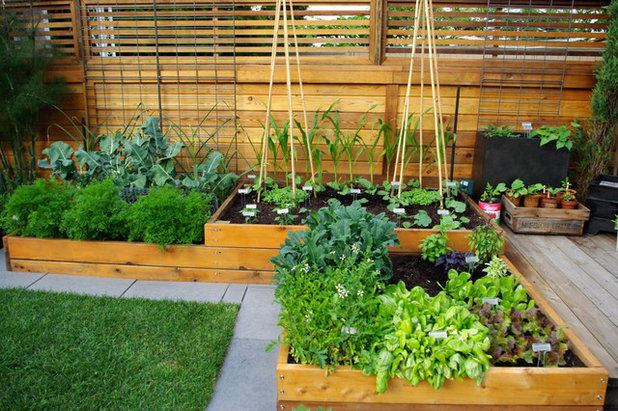
Aloe Designs
5. Make the garden work for you. Want to harvest fresh herbs and veggies in your slippers? Consider relocating your vegetable garden from the back of your yard to right against your patio or deck. If something is getting in the way of your enjoying your garden, then now is the time to get a sheet of paper, map out your property and evaluate how it’s really used. Be sure to note what kind of sunlight each area receives, as well as any obstacles such as tree roots and anything else that would impact the shape of your ideal garden.
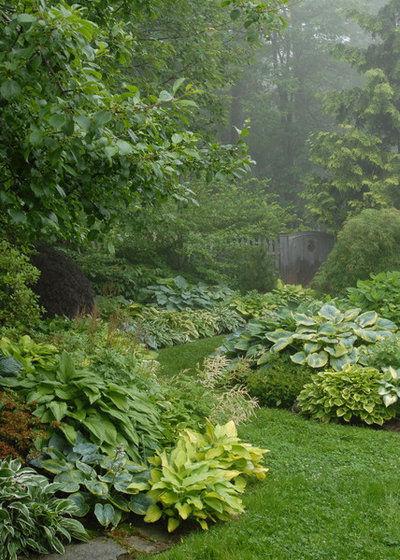
James R. Salomon Photography
5. Chisel away that lawn. Some homeowners like to have their lawn dominate the landscape, while others choose to eliminate it entirely. Most gardeners find a happy balance between the two and enjoy the benefits of a low-growing, even ground cover that’s soft underfoot — but in moderation.
Now is a great time, weather permitting, to determine the outlines of your garden borders. You can easily do this by laying out a garden hose or spraying chalk where the borders of the flower beds will lie. If you already have borders along the edge of your property and around trees or shrubs in the middle of the yard, you can extend the beds to where the lawn becomes something of an undulating path, like the one shown here. Next year you can always replace the grass path with hardscaping or mulch.
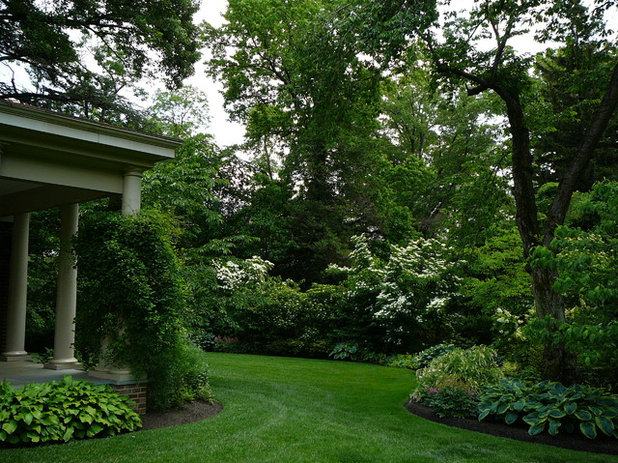
Wallace Landscape Associates
6. Make mowing easier. How easy is your lawn to mow? If it has an unusually complicated shape, sharp corners and poorly defined edges, simplifying the shape of your beds will help save you time in the long run.
Lay out a garden hose to form wide and sweeping curves or straight lines just outside your existing beds. If you have odd little peninsulas of garden beds that interrupt the flow of this shape, consider replacing these areas with turf. Using a motorized edger, a spade or an edging tool, you can make the division between your lawn and garden deeper and more defined, making it easier to trim and mow.
When you’re done digging and edging, spread out at least an inch of mulch to keep weeds from popping up.
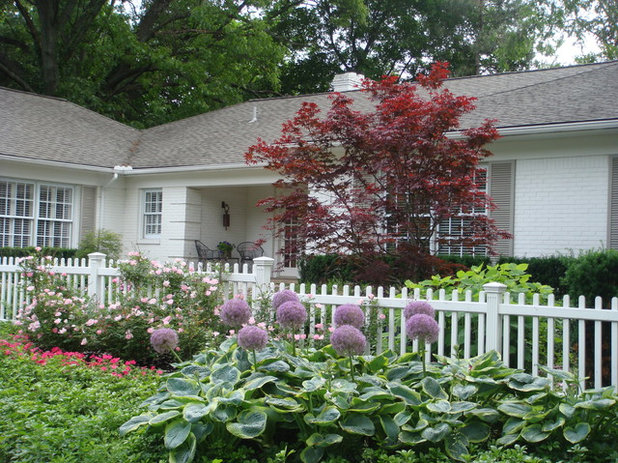
Great Oaks Landscape Associates Inc.
7. Reimagine your lawn. If lawn mowing and edging still seem like too much of a hassle (or just plain boring), you can always remove your lawn in part or entirely. A lawn is useful because it ties together the landscape visually and gives the eye both a place to rest and a place to go. That said, you can accomplish the same thing with repetition.
Massed
hostas (
Hosta spp, zones 5 to 9) and alliums (
Allium ‘Purple Sensation’, zones 4 to 9) are repeated here against a long, white picket fence that mirrors the white paint of the house. This harmonious and carefully chosen plant palette is warm and inviting, yet provides a degree of privacy that couldn’t be attained with a lawn.
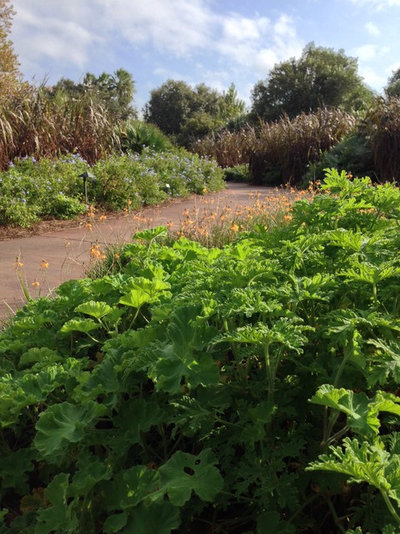 8. Commit to massing plants.
8. Commit to massing plants. If you take a walk around the neighborhood, you might notice that the prettiest front yards are dominated by one or a handful of plants that pull together the scene and let your eye wander without feeling overwhelmed. Some of my favorite plants to see in massed plantings include muhly grass (
Muhlenbergia capillaris, zones 7 to 11),
azaleas (
Azalea spp, zones 6 to 11) and
agapanthus (
Agapanthus orientalis, zones 7 to 11) but you’re bound to have your own picks, especially if you live in a colder climate.
Since you’re doing the smart thing by planning now instead of at the last minute during the spring rush, you have a valuable opportunity to decide upon the plants that you want to define your landscape. If there is a plant that has performed exceptionally well in your garden, why not plant more?
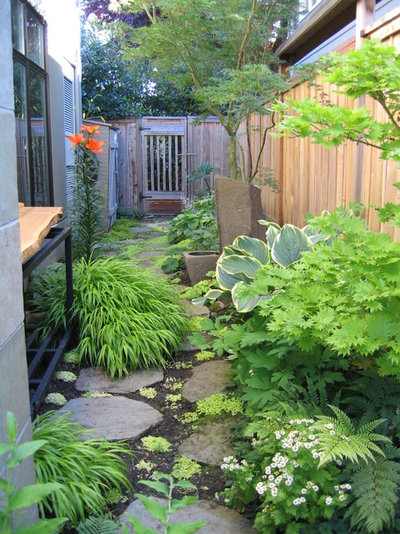
Rhodes Architecture + Light
9. Dress up a side yard. Side yards are often neglected and relegated to housing garbage cans and compost bins. They also don’t always get as much sun if they’re in a cramped area, and frequent traffic can result in a trodden path of mud and weeds. While side yards are usually pretty tight, they can be a valuable element of your overall garden design if used properly.
The side yard shown here might not be appropriate if you’d need to move lawnmowers and wheelbarrows over the carefully planted path, but the effect is quite lovely if having open access isn’t necessary. Alternately, you can plant gardens on each side of the yard, leaving a path of turf or hardscaping wide enough for a lawnmower or barbecue grill. Just be sure not to crowd the side of the house with plants, since doing so can invite problems with rot, mildew and insects. Side yards are also not a good place to plant things with aggressive roots.





